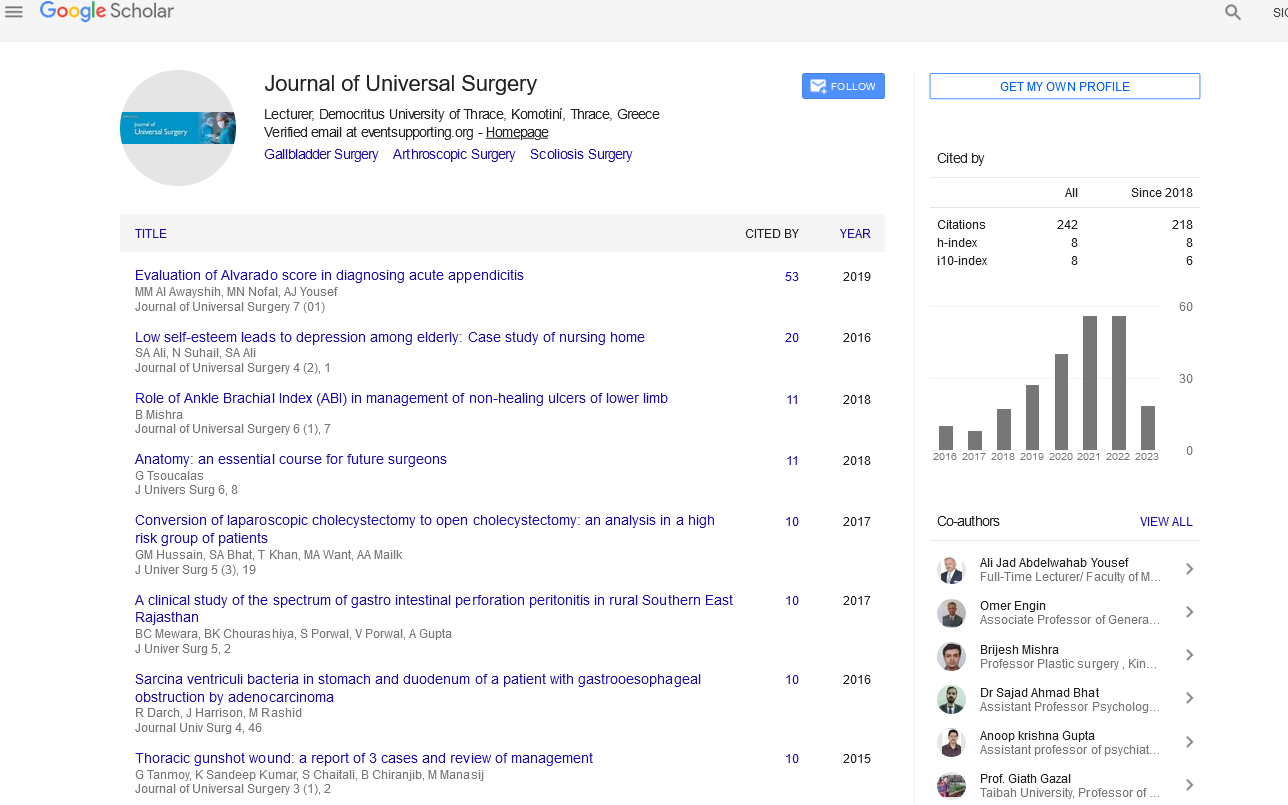Perspective - (2024) Volume 12, Issue 6
Discoveries in Scoliosis Surgery: Advancing Treatment Options and Outcomes
Jackson Miles*
Department of Oral Surgeon, Central Tilba University, Central Tilba, Australia
*Correspondence:
Jackson Miles, Department of Oral Surgeon, Central Tilba University, Central Tilba,
Australia,
Email:
Received: 26-Nov-2024, Manuscript No. IPJUS-24-15367;
Editor assigned: 29-Nov-2024, Pre QC No. IPJUS-24-15367 (PQ);
Reviewed: 13-Dec-2024, QC No. IPJUS-24-15367;
Revised: 21-Dec-2024, Manuscript No. IPJUS-24-15367 (R);
Published:
29-Dec-2024
Introduction
Scoliosis, a lateral curvature of the spine that often develops
during adolescence, has long posed significant challenges in
orthopedic care. Over the years, advancements in scoliosis
surgery have transformed treatment options, improved patient
outcomes and minimized risks. This article explores notable
discoveries in scoliosis surgery, focusing on innovations in
surgical techniques, technology integration and future prospects.
Description
The evolution of scoliosis surgery
The history of scoliosis surgery dates back to the early 20th
century, with the advent of basic spinal fusion techniques. These
early procedures were often invasive, associated with prolonged
recovery periods and had inconsistent outcomes. However, the
development of the Harrington rod system in the 1960s marked
a turning point. This metal rod, attached to the spine, became
the first standardized method for correcting spinal curvature.
Modern scoliosis surgery builds on this foundation with
advanced instrumentation and a deeper understanding of spinal
biomechanics. Surgeons now use more precise and less invasive
techniques, reducing recovery time and complications.
Key discoveries and innovations
Advancements in instrumentation: Pedicle Screw Fixation:
The introduction of pedicle screws revolutionized scoliosis
correction. Unlike traditional hooks and wires, pedicle screws
provide stronger fixation and allow for three-dimensional
correction of spinal deformities.
Expandable rod: For young patients, growing rods enable
spinal correction while accommodating growth. These rods can
be adjusted periodically without invasive surgery, thanks to
magnetically controlled systems.
Minimally Invasive Surgery (MIS)
Minimally invasive techniques have transformed scoliosis
surgery by reducing the size of incisions, minimizing blood loss,
and accelerating recovery. Advances such as lateral access and posterior MIS approaches have significantly improved patient
outcomes.
3D imaging and navigation systems
One of the most significant discoveries in scoliosis surgery is
the integration of 3D imaging and surgical navigation.
Technologies like intraoperative CT scans and O-arm systems
enable real-time visualization of spinal anatomy, enhancing the
accuracy of implant placement and minimizing errors.
Robotic-assisted surgery: Robotic systems are redefining
precision in scoliosis correction. Robotic arms, guided by
preoperative imaging, assist surgeons in planning and executing
highly accurate procedures. This technology reduces variability
and improves surgical consistency.
Biological innovations
The use of Bone Morphogenetic Proteins (BMPs) has been a
breakthrough in spinal fusion procedures. These proteins
stimulate bone growth, increasing the success rate of spinal
fusion and reducing the need for additional surgeries.
Improving outcomes through multidisciplinary care
Beyond surgical innovations, a multidisciplinary approach has
proven essential in managing scoliosis. Preoperative
physiotherapy, nutritional counseling and psychological support
contribute to better outcomes. Enhanced Recovery Protocols
(ERAS) have also gained traction, emphasizing pain management
and early mobilization.
Challenges and future directions
Despite significant progress, scoliosis surgery faces challenges
such as cost, access to advanced technologies and long-term
complications in some cases. However, ongoing research offers
hope for further breakthroughs:
Stem cell therapy: Investigating stem cells for enhancing
spinal fusion and reducing the need for synthetic materials. Artificial Intelligence (AI): AI-driven algorithms are being
developed to predict surgical outcomes and optimize treatment
plans. Custom implants: The rise of 3D printing could enable
personalized implants tailored to individual spinal anatomies,
improving correction and reducing complications.
Conclusion
Oral surgery is a distinctive and multifaceted discipline that
bridges the gap between dentistry and medicine. Its unique blend of technical precision, interdisciplinary collaboration and
patient-centered care makes it indispensable in addressing
complex oral and maxillofacial conditions. As technology and
techniques continue to evolve, oral surgery remains at the
forefront of innovation, ensuring better outcomes and improved
quality of life for patients worldwide.
Citation: Miles J (2024) Discoveries in Scoliosis Surgery: Advancing Treatment Options and Outcomes. J Univ Surg Vol.12 No.6: 059.





